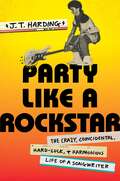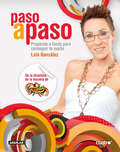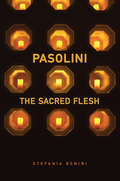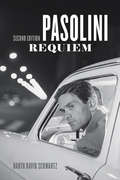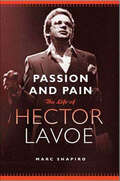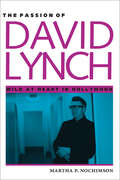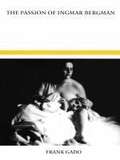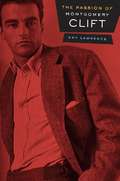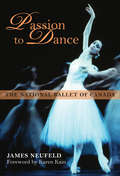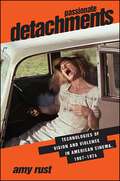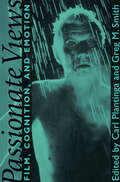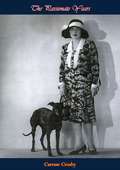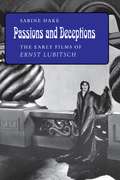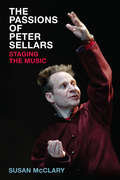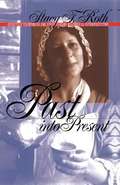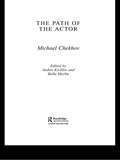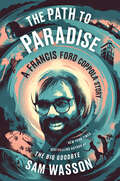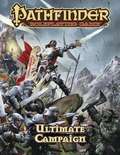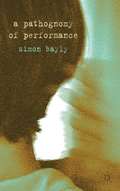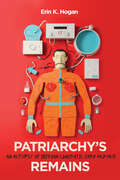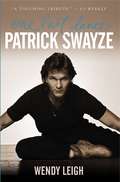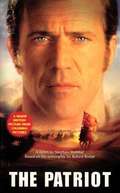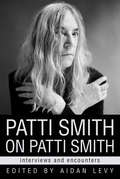- Table View
- List View
Party Like a Rockstar: The Crazy, Coincidental, Hard-Luck, and Harmonious Life of a Songwriter
by J.T. HardingThis fun and fast-paced rock-and-roll memoir from hit singer-songwriter J.T. Harding shows what it takes to go from South Detroit to the top of the Nashville charts.In PARTY LIKE A ROCKSTAR, J.T. Harding charts his life from a kid growing up in Michigan to a chart-topping songwriter living in Nashville and working with country music stars like Keith Urban and Kenny Chesney. As a kid playing rock n' roll in his parents' garage, Harding's was a world in which every taste of new music—from KISS to Prince and everyone in between—was a revelation. Inspired by his favorite artists, Harding abandons the classic "American Dream" and runs away to Los Angeles, where he forms a band and becomes part of the music scene there, all the while selling records to his favorite artists and producers at Tower Records.A story of youth, rebellion, and determination, PARTY LIKE A ROCKSTAR is a memoir for music lovers and an invaluable how-to guide for anyone who wants to learn how to write a hit song. Fun and heartfelt, Harding's memoir is the story of one man's unshakable love for rock and roll, how it guided him through some of the greatest tragedies—and greatest triumphs—of his wild and unvarnished life.
Paso a paso (Fama): Prepárate a fondo para conseguir tu sueño
by González, Lola¿Te gustaría conquistar tu sueño y no sabes por dónde empezar? ¿Fantaseas a menudo con la idea de triunfar sobre los escenarios? ¿Eres fan del programa Fama ¡a bailar! y quisieras seguir el ejemplo de alguno de los concursantes más queridos? Si harías lo que fuera por conseguir tu sueño, descubre que el secreto para alcanzarlo se esconde en tu interior. Abre bien los ojos y aprende paso a paso: - a rentabilizar tus dudas y a conocer tus limitaciones. - a cuidar tu imagen para que sea perfecta en cualquier entrevista o casting. - a valorar la importancia del trabajo y a interiorizar que la pasión y la entrega son los valores necesarios para conseguir el éxito. - a ser autodisciplinado, a escuchar, a preguntar y a trabajar en equipo. Lola González, la directora de la escuela de Fama ¡a bailar!, el programa de superación personal y de baile de más audiencia de la televisión, te ofrece en Paso a paso los mejores consejos y las anécdotas más divertidas de la escuela, y todo lo que ha aprendido como profesional de la danza y como profesora en los últimos años. Un libro divertido en el que encontrarás las herramientas necesarias para hacer realidad tu sueño.
Pasolini
by Stefania BeniniPoet, novelist, dramatist, polemicist, and filmmaker Pier Paolo Pasolini continues to be one of the most influential intellectuals of post-war Italy. In Pasolini: The Sacred Flesh, Stefania Benini examines his corporeal vision of the sacred, focusing on his immanent interpretation of the Christian doctrine of the Incarnation and the "sacred flesh" of Christ in both Passion and Death as the subproletarian flesh of the outcast at the margins of capitalism.By investigating the many crucifixions within Pasolini's poems, novels, films, cinematic scripts and treatments, as well as his subversive hagiographies of criminal or crazed saints, Benini illuminates the radical politics embedded within Pasolini's adoption of Christian themes. Drawing on the work of theorists such as Ernesto De Martino, Mircea Eliade, Jean-Luc Nancy, Alain Badiou, Giorgio Agamben, and Slavoj Žižek, she shows how Pasolini's meditation on the disappearance of the sacred in our times and its return as a haunting revenant, a threatening disruption of capitalist society, foreshadows current debates on the status of the sacred in our postmodern world.
Pasolini Requiem: Second Edition
by Barth David SchwartzPier Paolo Pasolini (1922–75) was one of the most important Italian intellectuals of the post–World War II era. An astonishing polymath—poet, novelist, literary critic, political polemicist, screenwriter, and film director—he exerted profound influence on Italian culture up to his untimely death at the age of fifty-three. This revised edition of what the New York Times Book Review has called “the standard Pasolini biography” introduces the artist to a new generation of readers. Based on extensive interviews with those who knew Pasolini, both friends and enemies, admirers and detractors, Pasolini Requiem chronicles his growth from poet in the provinces to Italy’s leading “civil poet”; his flight to Rome in 1950; the scandalous success of his two novels and political writing; and his transition to film, where he started as a contributor to the golden age of Italian cinema and ended with the shocking Salò, or the 120 Days of Sodom. Pasolini’s tragic and still unsolved murder has remained a subject of contentious debate for four decades. The enduring fascination with who committed the crime—and why—reflects his vital stature in Italy’s political and social history. Updated throughout and with a new afterword covering the efforts to reopen the investigation—and the legal maelstrom surrounding Pasolini’s demise—this edition of Pasolini Requiem is a riveting account of one of the twentieth century’s most controversial, ever-present iconoclasts.
Passion and Pain: The Life of Hector Lavoe
by Marc ShapiroA definitive biography of Hector Lavoe's rise from Puerto Rico to stardom in New York that led to sold-out concerts and best-selling salsa albums, yet gave way to drug addiction, a strained marriage and tragedy.From the poverty-stricken streets of Ponce, Puerto Rico to the vibrant barrios of New York City, HECTOR LAVOE became the singer of all singers, and the driving-force behind the Salsa movement in the mid-1960s. His popularity rivaled that of his contemporaries, Tito Puente, Celia Cruz and Johnny Pacheco.Behind the music, Hector's life was filled with drugs, alcohol and women. An endless stream of tragedy plagued him, including a gun-related accident that killed his son, Hector's ninth floor jump from a hotel window, and his death in 1993 from AIDS. But Hector's pristine voice, one-of-a-kind stage performances, sold-out concerts and bestselling albums were what his fans remember most and what made him an international icon. His music brought joy to legions of people, and it continues today.Marc Shapiro's Passion and Pain is "A no-holds barred biography" (Uptown Magazine) of a fascinating life.
Passion for the Piano
by Judith OringerEvolution of the piano, its manufacturing, care of a piano, piano competitions, the piano in literature and films, and politics and the piano.
The Passion of David Lynch: Wild at Heart in Hollywood
by Martha P. NochimsonFilmmaker David Lynch asserts that when he is directing, ninety percent of the time he doesn't know what he is doing. To understand Lynch's films, Martha Nochimson believes, requires a similar method of being open to the subconscious, of resisting the logical reductiveness of language. In this innovative book, she draws on these strategies to offer close readings of Lynch's films, informed by unprecedented, in-depth interviews with Lynch himself. Nochimson begins with a look at Lynch's visual influences-Jackson Pollock, Francis Bacon, and Edward Hopper-and his links to Alfred Hitchcock and Orson Welles, then moves into the heart of her study, in-depth analyses of Lynch's films and television productions. These include Twin Peaks: Fire Walk with Me, Wild at Heart, Twin Peaks, Blue Velvet, Dune, The Elephant Man, Eraserhead, The Grandmother, The Alphabet, and Lynch's most recent, Lost Highway. Nochimson's interpretations explode previous misconceptions of Lynch as a deviant filmmaker and misogynist. Instead, she shows how he subverts traditional Hollywood gender roles to offer an optimistic view that love and human connection are really possible. Martha P. Nochimson is Professor of Film and Literature at Mercy College in Dobbs Ferry, New York. She also has taught for ten years at the Tisch School of the Arts at New York University
The Passion of Ingmar Bergman
by Frank GadoAcknowledged as one of the greatest filmmakers of this or any other time, Bergman has with few exceptions written his own screenplays--an uncommon practice in the film industry--and for this practice critics refer to him as a "literary" filmmaker: In this work, Gado examines virtually the entire range of Bergman's literary output. While treating the matter of the visual presentation of Bergman's films, Gado concentrates on story and narrative and their relationship to Bergman's personal history.Gado concludes that whatever the outward appearance of Bergman's works, they contain an elementary psychic fantasy that links them all, revealing an artist who hoped to be a dramatist, "the new Strindberg," and who saw the camera as an extension of his pen.
The Passion of Montgomery Clift
by Amy LawrenceChallenging the myth of Clift, actor, as tragic victim, Amy Lawrence explores the way Clift's extraordinary looks, controversial sexuality, and the accident that allegedly changed the course of his career continue to feed the religious intensity of fan discourse.
Passion to Dance: The National Ballet of Canada
by James NeufeldThis is the story of the National Ballet of Canada – the people, the determination, and how at sixty it is still creating new work while still representing the classics. Passion to Dance is the story of the National Ballet of Canada – the people who dreamt the company into existence, the determination needed to keep it afloat, the bumps on the road to its success, and above all, its passion for dance as a living, evolving art form. From catch-as-catch-can beginnings – borrowed quarters, tiny stages, enormous dreams the National Ballet has emerged as one of North America’s foremost dance troupes. The company at sixty is a company of its time, engaged in creating challenging new work, yet committed to maintaining the classics of the past, favourites like Swan Lake, The Nutcracker,and The Sleeping Beauty. One hundred and fifty photographs from the company’s archives illustrate this definitive history, filled with eyewitness accounts, backstage glimpses, and fascinating detail. This is a record of one of Canada’s boldest cultural experiments, a book to enjoy now and keep forever.
Passionate Detachments: Technologies of Vision and Violence in American Cinema, 1967-1974 (SUNY series, Horizons of Cinema)
by Amy RustPassionate Detachments investigates the rise of graphic violence in American films of the late 1960s and early 1970s and the popular aesthetics and critical responses this violence inspired. Amy Rust examines four technologies adopted by commercial American cinema after the fall of the Hollywood Production Code: multiple-camera montage, squibs (small explosive devices) and artificial blood, freeze-frames, and zooms. Approaching these technologies as figures, as opposed to mere tools, Rust traces the encounters they mediate between perception (what one sees, hears, and feels) and representation (how those sights, sounds, and feelings make meaning). These technologies, she argues, lend shape to film violence while organizing viewers' on- and off-screen relationships to it.The result proves meaningful for an era self-consciously and perilously preoccupied with bloodshed. The post-Code period found Americans across the political spectrum demanding visual—and increasingly violent—demonstrations of presumably "authentic" realities. Corroborating fantasies of authenticity from military to counterculture, these technologies challenge them as well, pointing, however unwittingly, to the violently classed, gendered, and racialized blind spots such fantasies harbor. More broadly, the technologies answer concerns that films control violence too much or too little. Offering neither mere discourse nor mere thrills, they recover sense and sensation for all, not some, or even most, depictions of bloodshed. As figures, the devices also remediate vision and violence for film theory, which exhibits distrust for each in spite of the complexities phenomenology and psychoanalysis have brought to cinematic perception and pleasure.
Passionate Views: Film, Cognition, and Emotion
by Carl Plantinga and Greg M. SmithThe movie theater has always been a place where people come together to share powerful emotional experiences, from the fear generated by horror films and the anxiety induced by thrillers to the laughter elicited by screwball comedies and the tears precipitated by melodramas. Indeed, the dependability of movies to provide such experiences lies at the center of the medium's appeal and power. Yet cinema's ability to influence, even manipulate, the emotions of the spectator is one of the least-explored topics in film theory today.In Passionate Views, thirteen internationally recognized scholars of film studies, philosophy, and psychology explore the emotional appeal of the cinema. Employing a novel cognitive perspective, the volume investigates the relationship between genre and emotion; explores how film narrative, music, and cinematic techniques such as the close-up are used to elicit emotion; and examines the spectator's identification with and response to film characters.An impressive range of films and topics is brought together by Carl Plantinga and Greg M. Smith, including: the success of Stella Dallas and An Affair to Remember as tearjerkers; the power of Night of the Living Dead to inspire fear and disgust; the sublime evoked in The Passion of Joan of Arc, Aguirre, the Wrath of God, and The Children of Paradise; the emotional basis of film comedy as seen in When Harry Met Sally; the use of cinematic cues in Raiders of the Lost Ark and Local Hero to arouse emotions; the relationship between narrative flow and emotion in Once Upon a Time in the West and E.T.; the emotive use of music in The Elephant Man and A Clockwork Orange; Stranger than Paradise's sense of timing; desire and resolution in Casablanca; audience identification with the main characters in Groundhog Day and The Crying Game; portrayal of perversity in The Silence of the Lambs, Flaming Creatures, and Shivers; and empathy elicited through closeups of actors' faces in Yankee Doodle Dandy and Blade Runner.Passionate Views offers a new approach to our understanding of film and will be of interest to anyone fascinated by the emotional power of motion pictures and their relationship to the central concerns of our lives, as well as by the techniques filmmakers use to move an audience.
The Passionate Years
by Caresse CrosbyA mad, amusing, and revealing look at Paris in the twenties and at the people Caresse Crosby knew—Hemingway, F. Scott Fitzgerald, Edith Wharton, James Joyce, Picasso, Ezra Pound, T. S. Eliot, Lawrence of Arabia, and a host of others. In a single day, a visitor to the Crosby home outside of Paris might have found Salvador Dali at work in one room, Douglas Fairbanks Senior playfully swinging from the rafters, and D. H. Lawrence sunning himself by the pool.“In her autobiography Mrs. Crosby has added a valuable footnote to the literary history of our time....She tells some amazingly good stories. Her account of Lindbergh’s arrival in Paris is a superb piece of straight reporting and her description of a Quatre Arts ball at which she won first prize for reasons that cannot be mentioned in a family newspaper is funny and sad at the same time. Her fostering of unknown or otherwise unpublishable writers (Crane, Joyce, D. H. Lawrence, among others) through the Black Sun Press can now be seen clearly for the important project it was.—The New York Times“The Passionate Years becomes immediately an essential document of its era. Also it is an entertaining book.”—New York Herald Tribune
Passions and Deceptions: The Early Films of Ernst Lubitsch
by Sabine HakeA collaborator with Warner Brothers and Paramount in the early days of sound film, the German film director Ernst Lubitsch (1892-1947) is famous for his sense of ironic detachment and for the eroticism he infused into such comedies as So This Is Paris and Trouble in Paradise. In a general introduction to his silent and early sound films (1914-1932) and in close readings of his comedies, Sabine Hake focuses on the visual strategies Lubitsch used to convey irony and analyzes his contribution to the rise of classical narrative cinema. Exploring Lubitsch's depiction of femininity and the influence of his early German films on his entire career, she argues that his comedies represent an important outlet for dealing with sexual and cultural differences. The readings cover The Oyster Princess, The Doll, The Mountain Cat, Passion, Deception, So This Is Paris, Monte Carlo, and Trouble in Paradise, which are interpreted as part of an underlying process of negotiation between different modes of representation, narration, and spectatorship--a process that comprises the conditions of production in two different national cinemas and the ongoing changes in film technology. Drawing attention to Lubitsch's previously neglected German films, this book presents the years until 1922 as the formative period in his career.
The Passions of Peter Sellars: Staging the Music
by Susan McClaryRecognized as one of the most innovative and influential directors of our time, Peter Sellars has produced acclaimed—and often controversial—versions of many beloved operas and oratorios. He has also collaborated with several composers, including John C. Adams and Kaija Saariaho, to create challenging new operas. The Passions of Peter Sellars follows the development of his style, beginning with his interpretations of the Mozart-Da Ponte operas, proceeding to works for which he assembled the libretti and even the music, and concluding with his celebrated stagings of Bach’s passions with the Berlin Philharmonic. Many directors leave the musical aspects of opera entirely to the singers and conductor. Sellars, however, immerses himself in the score, and has created a distinctive visual vocabulary to embody musical gesture on stage, drawing on the energies of the music as he shapes characters, ensemble interaction, and large-scale dramatic trajectories. As a leading scholar of gender and music, and the history of opera, Susan McClary is ideally positioned to illuminate Sellars’s goal to address both the social tensions embodied in these operas as well as the spiritual dimensions of operatic performance. McClary considers Sellars’s productions of Mozart’s Le nozze di Figaro, Don Giovanni, and Così fan tutte; Handel’s Theodora; Messiaen’s Saint François d’Assise; John C. Adams’s Nixon in China, The Death of Klinghoffer, El Niño, and Doctor Atomic; Kaija Saariaho’s L’amour de loin, La Passion de Simone, and Only the Sound Remains; Purcell’s The Indian Queen; and Bach’s passions of Saint Matthew and Saint John. Approaching Sellars’s theatrical strategies from a musicological perspective, McClary blends insights from theater, film, and literary scholarship to explore the work of one of the most brilliant living interpreters of opera.
Past Imperfect
by Joan CollinsJoan Collins, star of films and TV, tells the story of her life. She grew up in England, married young, and several times. She had several love affairs, beautiful children, and a life many women would love.
Past into Present: Effective Techniques for First-Person Historical Interpretation
by Stacy F. RothThe portrayal of historical characters through interactive dramatization or role-playing is an effective, albeit controversial, method used to bring history to life at museums, historic sites, and other public venues. Stacy Roth examines the techniques of first-person interpretation to identify those that have been most effective with audiences while allowing interpreters to maintain historical fidelity.
The Path Of The Actor
by Michael ChekhovThis is the first English translation of Michael Chekhov’s two-volume autobiography, combining The Path of the Actor (1927) and extensive extracts from his later volume Life and Encounters. Full of illuminating anecdotes and insightful observations involving prominent characters from the MAT and the European theatre of the early twentieth century, Chekhov takes us through events in his acting career and personal life, from his childhood in St. Petersburg until his emigration to Latvia and Lithuania in the early 1930s. Accompanying Chekhov's witty, penetrating, and immensely touching accounts are extensive and authoritative notes compiled by leading Russian Chekhov scholar, Andrei Kirillov. Anglo-Russian trained actor Bella Merlin provides a useful hands-on overview of how the contemporary practitioner might utilise and develop Chekhov's ideas. Chekhov was arguably one of the greatest actors of the twentieth century. His life made a huge impact on his profession, and his actor-training techniques inspired many a Hollywood legend – including such actors as Anthony Hopkins and Jack Nicholson -while his books outlining his teaching methods and philosophy of acting are still bestsellers today The Path of the Actor is an extraordinary document which allows us unprecedented access into the life, times, mind and soul of a truly extraordinary man.
The Path to Paradise: A Francis Ford Coppola Story
by Sam Wasson“Sam Wasson’s supremely entertaining book tracks the ups and downs, ins and outs, of a remarkable career. . . . A marvel of unshowy reportage.”—New York TimesThe New York Times bestselling author of Fifth Avenue, 5 A.M. and The Big Goodbye returns with the definitive account of Academy Award–winning director Francis Ford Coppola’s decades-long dream to reinvent American filmmaking, if not the entire world, through his production company, American Zoetrope.Francis Ford Coppola is one of the great American dreamers, and his most magnificent dream is American Zoetrope, the production company he founded in San Francisco years before his gargantuan success, when he was only thirty. Through Zoetrope’s experimental, communal utopia, Coppola attempted to reimagine the entire pursuit of moviemaking. Now, more than fifty years later, despite myriad setbacks, the visionary filmmaker’s dream persists, most notably in the production of his decades-in-the-making film and the culmination of his utopian ideals, Megalopolis.As Wasson makes clear, the story of Zoetrope is also the story of Coppola’s wife, Eleanor Coppola, and their children, and of personal lives inseparable from artistic passion. It is a story that charts the divergent paths of Coppola and his cofounder and onetime apprentice, George Lucas, and of their very different visions of art and commerce. And it is a story inextricably bound up in the making of one of the greatest quixotic masterpieces ever attempted, Apocalypse Now, and in what Coppola found in the jungles of the Philippines when he walked the razor’s edge. That story, already the stuff of legend, has never fully been told, until this extraordinary book.
Pathfinder Roleplaying Game: Ultimate Campaign
by Paizo PublishingPathfinder RPG Ultimate Campaign is an invaluable addition to the Pathfinder RPG Core Rulebook. This imaginative tabletop games builds on more than 10 years of system development and an open playtest featuring more than 50,000 gamers to create a cutting-edge RPG experience that brings the all-time-best-selling set of fantasy rules into the new millennium. The Pathfinder RPG Ultimate Campaign includes: An extensive system for generating character and NPC backgrounds, history, and family, from the son of the farmer to the king's daughter; innovative new story feats that tie your character's background and experiences into the game, giving players goals to accomplish for even greater rewards; a complete system for tracking what your character does between adventures, from opening a tavern to crafting a powerful magic item; a number of systems to expand Pathfinder play, including fame, honor, relationships, and more; rules for building and maintaining a kingdom, from a small town to a mighty nation; and a simple system for taking kingdoms and larger armies to war against their neighbors or even incredibly powerful monsters, like ancient dragons or the terrifying tarrasque.
A Pathognomy of Performance
by Simon BaylyExploring the themes of the event, ephemerality and democracy that mark the encounter between performance and philosophy, this original study elaborates fresh perspectives on the experiences of undoing, fiasco and disaster that shadow both the both stage and everyday life.
Patriarchy’s Remains: An Autopsy of Iberian Cinematic Dark Humour (McGill-Queen's Iberian and Latin American Cultures Series #8)
by Erin K. HoganSomething is rotten in the state of Spain. The uninterred corpse of a patriarchal figure populates the visual landscapes of Iberian cinemas. He is chilled, drugged, perfumed, ventilated, presumed dead, speared in the cranium, and worse.Analyzing a series of Iberian cinematic dark comedies from the 1950s to the present day, Patriarchy’s Remains argues that the cinematic trope of the patriarchal death symbolizes the lingering remains of the Francisco Franco dictatorship in Spain (1939–75). These films, created as satirical responses to persisting economic, social, and political issues, demonstrate that Spain’s transition to democracy following the Francoist period is an incomplete and ongoing process. Within the theme of patriarchal decay, the significance of the figure differs across cinematic representations, from his indispensability to his obstructionism and exploitation. Erin Hogan traces the prevalence of patriarchal death by analyzing its relationship with the surrounding characters who must depend on the deceased. Hogan demonstrates how the patriarch’s persistence in film both reveals and challenges an array of discriminations and inequalities in the cinematic grotesque tradition, in Iberian cinemas more broadly, and in Iberian society as a whole.Despite Spain’s ongoing transition towards democratic pluralism, Patriarchy’s Remains serves as a reminder that the remnants of an entrenched although not interred patriarchal culture continue to haunt Iberian society.
Patrick Swayze: One Last Dance
by Wendy LeighA heartwarming, in-depth portrait of the beloved star whose sensational performances in Dirty Dancing and Ghost seduced a generation, and whose courage in the face of illness captivated millions For almost thirty years, Patrick Swayze has been an American icon of masculinity and sex appeal, strong but sensitive, romantic yet dangerous. In this intimate and revealing biography, New York Times bestselling author Wendy Leigh shares the inspiring untold story of Patrick's incredible life: his show business childhood, his fairy-tale love affair with wife Lisa Niemi, his catapult into alcoholism after his father's untimely death, the daredevil exploits that almost killed him, and his courageous fight against pancreatic cancer, a fight that has off-ered hope and encouragement to others grap-pling with similar life-threatening illnesses. Ever since the steamy low-budget film Dirty Dancing skyrocketed Patrick to fame and cemented his place in the hearts of audiences around the world, he has been one of our most cherished public figures. Based on interviews with countless sources who have never spoken about Patrick before -- from the Texas beauty who shared his first kiss, to the woman he almost married, to the manager who worked closely with him from his teen idol days until his romantic tour de force in Ghost -- and many more, Leigh unveils surprising details about the charismatic actor's life on- and off-screen. Beginning with his training as a dancer with his choreographer mother and spanning his remarkable -- and at times challenging -- career, this groundbreaking biography of the un-forgettable entertainer is the mesmerizing, enduring, and definitive story of a man who captured our hearts.
The Patriot
by Stephen Molstad Robert RodatIn Britain's American colonies, the cry goes out for freedom as the air from Lexington to the Carolinas burns hot with powder smoke and cannon fire. But Benjamin Martin has had his fill of war. A veteran of the fierce French and Indian conflict, he has renounced fighting forever, retiring to his South Carolina farm to raise his motherless children in peace. Now the war has found his hiding place, bringing its senseless cruelty back into his life and destroying what he holds most dear. And Benjamin Martin must take up arms to fight again--to lead a makeshift army of brave farmers and craftsmen against a relentless, overwhelming enemy--in the blessed cause of liberty. . . and blood vengeance.
Patti Smith on Patti Smith: Interviews and Encounters (Musicians in Their Own Words)
by Aidan LevyFrom the moment Patti Smith burst onto the scene, chanting "Jesus died for somebody's sins, but not mine," the irreverent opening line to Horses, her 1975 debut album, the punk movement had found its dissident intellectual voice. Yet outside the recording studio—Smith has released eleven studio albums—the punk poet laureate has been perhaps just as revelatory and rhapsodic in interviews, delivering off-the-cuff jeremiads that emboldened a generation of disaffected youth and imparting hard-earned life lessons. With her characteristic blend of bohemian intellectualism, antiauthoritarian poetry, and unflagging optimism, Smith gave them hope in the transcendent power of art. In interviews, Smith is unfiltered and startlingly present, and prescient, preaching a gospel bound to shock or inspire. Each interview is part confession, part call-and-response sermon with the interviewer. And there have been some legendary interviewers: William S. Burroughs, Thurston Moore (of Sonic Youth), and novelist Jonathan Lethem. Her interview archive serves as a compelling counternarrative to the albums and books. Initially, interviewing Patti Smith was a censorship liability. Contemptuous of staid rules of decorum, no one knew what she might say, whether they were getting the romantic, swooning for Lorca and Blake, or the firebrand with no respect for an on-air seven-second delay. Patti Smith on Patti Smith is a compendium of profound and reflective moments in the life of one of the most insightful and provocative artists working today.
